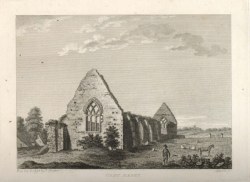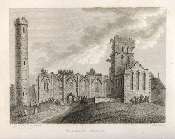« April 2005 | Main | June 2005 »
May 04, 2005
GROSE'S ANTIQUITIES 1792 GREY ABBEY KILDARE

GRAY ABBEY.
THIS plate exhibits the north-west view of the abbey. The roof at this end is totally decayed, but the walls and eastern windows remain nearly entire. On a gravestone in the church-yard is the following epitaph:
Here lies Jean Hay,
Who night and day
Was honest, good, and just;
Her hope and love
Was from above,
In which place was her trust.
Her spirit left her terrene part,
With joy to God, where was her heart.
On the 4th day of January, 1706 / 7.
THIS View was drawn by Lieutenant Daniel Grose, anno 1792.
(p. 83, Vol. II)
Grey Abbey Kildare - history of Grey Abbey is mistakenly included under Kildare Abbey (pp. 25-26, Vol. I).
The original entry for Kildare Cathedral is recorded as follows...
Groses's Antiquities of Ireland: - County Kildare in the 1790's
KILDARE ABBEY, KILDARE.
(It seems to confuse Grey Abbey with Kildare Cathedral. The accompanying image and description is of the Cathedral but the early part of the history refers to Grey Abbey at Kildare - Mario Corrigan)
THIS town, situated about 28 miles from Dublin, was early celebrated for the virtue and miracles of St. Bridget, and for an inextinguishable fire preserved by her nuns. The latter succeeded the Druidesses, among whom fire was a sacred element, and kept with singular care.
THIS, called the Gray Abbey, is on the south side of the town, and was erected for friars of the Franciscan order in the year 1260, by Lord William de Vescy, but the building was completed by Gerald Fitz Maurice, Lord Offaley. He died in 1286, at Rathmore, near Naas, and was interred here.
JOHN Fitz Thomas, the first Earl of Kildare, dying at Larraghbrine near Maynooth, was buried in this church A. D. 1316. This nobleman had great variance with William de Vescy, Lord of Kildare and Lord Justice. They appealed to the king, and the Lord Justice was challenged, but declined the combat, and fled into France, whereupon the king pronounced John Fitz Thomas innocent, and bestowed on him the title of Earl of Kildare, which the other enjoyed. Three other earls of this noble house are entombed in this friary.
THE 34th Henry VIII. this monastery with its appurtenances, two gardens, and two closes of land with four messuages, &c. together with the house of the White Friars, were granted in capite to Daniel Sutton, at the annual rent of 2S. 3d. Irish money.
PART of the tower of this church still remains, and a portion of the walls, which show it to have been well constructed. The round tower adjoining it is a beautiful object. We see here six Gothic arches and as many buttresses. The north side of the steeple is leveled with the ground, said to have been beaten down by a battery planted against it in the rebellion 1641. The south wing is in ruins, it was formerly a chapel, and in it are two statues in alto relievo. One represents a bishop in his robes, a pastoral staff in his right hand, and a mitre on his head, supported by two monkeys. As there is no inscription, it is conjectured to belong to Edmund Lane, Bishop of Kildare, who was buried here A. D. 1522. The other is a monument of Sir Maurice Fitz Gerald of Lackugh, curiously cut in armour, with an inscription and five escutcheous differently emblazoned.
THE round tower is 132 feet high, adorned with a battlement, and not far from this is the fire-house. Henry de Loundres, Archbishop of Dublin in 1220, put out the fire, but it was re-lighted after, and continued to burn till the suppression of monasteries. One miracle attendant on this fire was, that notwithstanding its perpetual consumption of fuel, ashes never increased: nor was the fire ever to be blown by human breath for fear of contamination, but by vans or bellows.

This view, was taken from a drawing by Dr.Wynne.
(pp. 25-26, Vol. I)
Posted by mariocorrigan at 08:16 PM
The Aims of the Grey Abbey Conservation Project
What we're all about!
The Grey Abbey of Franciscan Friars was established around 1260 by William De Vesci but was to thrive under the patronage of the Fitzgeralds, Lords of Offaly and Earls of Kildare. The Fitzgeralds were, for centuries, the strongest and most powerful family in Ireland and their attachment to the town and manor of Kildare is demonstrated by the internment of at least nine Earls at Kildare. Four of those, including the first three Fitzgeralds to enjoy the title of Earl of Kildare, were buried at Grey Abbey.
Apart from the traditional benefits to the town and outlying areas that can be associated with the establishment of an Order of Friars, the Grey Abbey was also famous as a place of learning. Some of the earliest poems written in the English language in Ireland are attributed to a Friar Michael of Kildare and were supposedly written at Grey Abbey, possibly as early as 1308-1315. The manuscript is now housed in the British Library. An other famous Franciscan, Brother Michael Cleary, one of the compilers of the Four Masters, transcribed poems at Grey Abbey in 1627.
The Abbey is an important part of the history of the town of Kildare but is sadly in a state of ruin. It is a protected monument and is included in the zone of protection which encompasses the medieval walled town of Kildare which is clearly indicated on the 6 inch SMR Map, sheet 22. The walls which now enclose the Abbey and graveyard are clearly within the area of protection. However archaeological reports, including ‘The Urban Archaeological Survey,’ by John Bradley et. al. clearly establish the remains of claustral foundations outside the south wall in the adjoining field. Articles in the Kildare Archaeological Journal and references in other sources establish provenance for a much larger community attached to the original friary. In the 1992, Environmental Impact Study for the then proposed Kildare Town By-Pass, the County Architect, Niall Meagher indicated that “the environmental area of the Abbey site requiring protection does extend to the boundary suggested in the Urban Archaeological Survey.” The concerns for The Grey Abbey Conservation Project therefore focus on ‘Grey Abbey’ in its broadest possible sense.
The aims of the Project must take into account the ruinous state of the Abbey itself and the urgent need for archaeological investigation. Regardless of the prohibitive cost and the probable long-term nature attached to any such conservation project, a Plan of Action must be formulated by the Project Committee to present the aims of the Project to Government Departments, State Agencies, Kildare Local Authorities and all other interested parties including private enterprise. The intention being to source funding, raise the profile of the project and galvanise support for the conservation of Grey Abbey ‘to make a positive contribution to the presentation of the historic town of Kildare and act as an amenity both for the people of the town and its visitors,’ (Mount 1992).
Posted by mariocorrigan at 04:45 PM